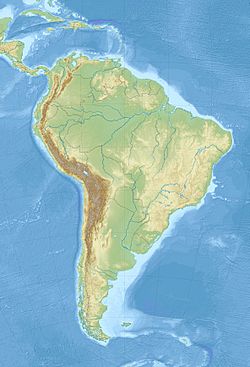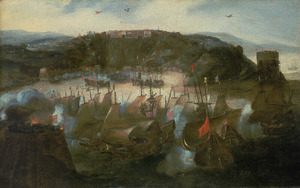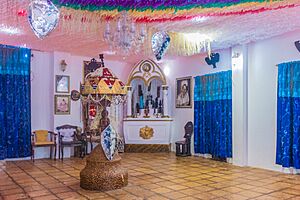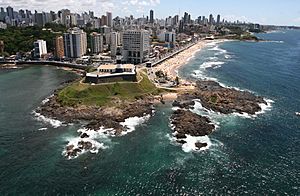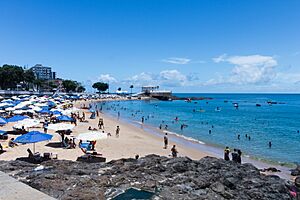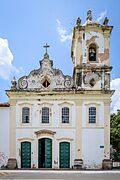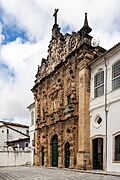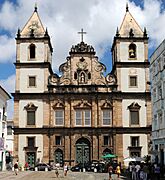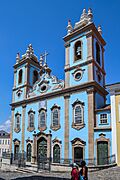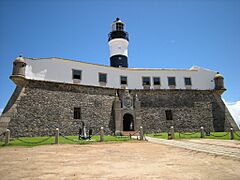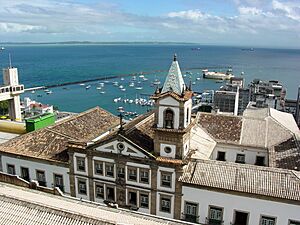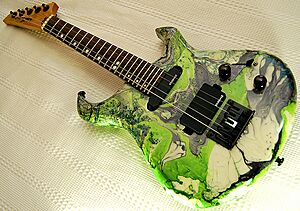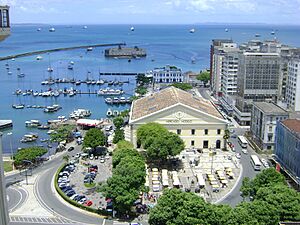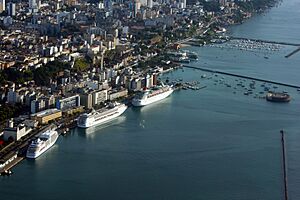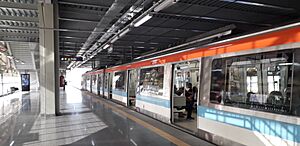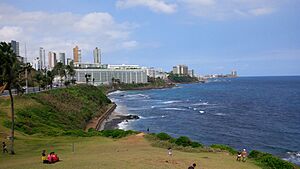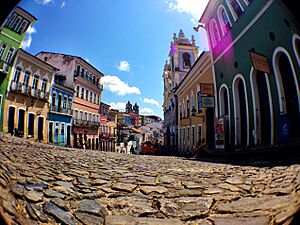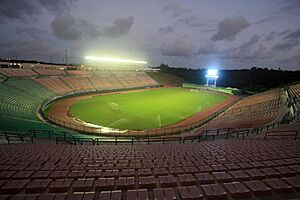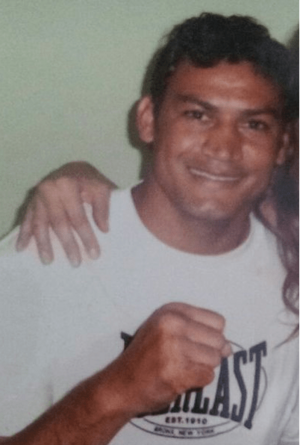Salvador, Bahia facts for kids
Quick facts for kids
Salvador
|
|||||||||||||
|---|---|---|---|---|---|---|---|---|---|---|---|---|---|
|
Municipality
|
|||||||||||||
| Municipality of Salvador Município de Salvador |
|||||||||||||
|
Skyline of Salvador from Barra
Barra Lighthouse
Pelourinho
Monument to the Second of July
Historic Center
Lacerda Elevator
Panoramic view of the Vitória neighborhood
|
|||||||||||||
|
|||||||||||||
| Nickname(s):
Roma Negra ("Black Rome") and Soterópolis ("Savior City", by translating "Salvador" into Greek)
|
|||||||||||||
| Motto(s):
Sic illa ad arcam reversa est (Latin)
"So she returned to the ark" |
|||||||||||||

Location of Salvador in the State of Bahia
|
|||||||||||||
| Country | |||||||||||||
| Region | Northeast | ||||||||||||
| State | Bahia | ||||||||||||
| Founded | 29 March 1549 | ||||||||||||
| Area | |||||||||||||
| • Municipality | 693 km2 (268 sq mi) | ||||||||||||
| • Water | 66.91 km2 (25.83 sq mi) | ||||||||||||
| • Metro | 4,375.123 km2 (1,689.244 sq mi) | ||||||||||||
| Elevation | 8 m (26 ft) | ||||||||||||
| Population
(2020)
|
|||||||||||||
| • Municipality | 2,417,678 (5th) | ||||||||||||
| • Density | 4,187/km2 (10,840/sq mi) | ||||||||||||
| • Metro | 3,919,864 (7th) | ||||||||||||
| • Metro density | 891.3/km2 (2,308/sq mi) | ||||||||||||
| Demonym(s) | Portuguese: Soteropolitano/a English: Soteropolitan | ||||||||||||
| Metropolitan GDP (PPP, constant 2015 values) | |||||||||||||
| • Year | 2023 | ||||||||||||
| • Total | $49.0 billion | ||||||||||||
| • Per capita | $12,700 | ||||||||||||
| Time zone | UTC−3 (BRT) | ||||||||||||
| Postal code |
40000-001 to 42599-999
|
||||||||||||
| Area code | +55 71 | ||||||||||||
| HDI (2010) | 0.759 – high | ||||||||||||
|
|||||||||||||
Salvador is a big city in Brazil and the capital of the Bahia state. It's famous for its amazing food, lively music, and beautiful buildings. Because of its strong Afro-Brazilian culture, Salvador is a very special place. It was the first capital of Colonial Brazil, founded in 1549 by Tomé de Sousa. This makes it one of the oldest cities in the Americas.
Salvador is built on a hilly area, with an "Upper Town" and a "Lower Town." Its coast is surrounded by the Bay of All Saints and the Atlantic Ocean. The Historic Center of Salvador, especially the area around Pelourinho, is known for its old colonial buildings from the 1600s to the early 1900s. UNESCO named it a World Heritage Site in 1985. Salvador also hosts one of the biggest Carnivals in the world, a huge street party! It's even called a "City of Music" by UNESCO, which is a unique title in Brazil.
With over 2.4 million people in 2020, Salvador is the most populated city in Brazil's Northeast region and the fifth largest in the whole country. It's also part of a larger metropolitan area called "Great Salvador," which has almost 4 million people. This makes it one of the biggest city areas in South America.
Salvador is an important center for business, trade, and tourism. It's home to many big companies and has hosted major events like the 2014 FIFA World Cup.
Contents
History of Salvador
![]() Portuguese Empire 1549–1815
Portuguese Empire 1549–1815
![]() Dutch Brazil 1624–1625
Dutch Brazil 1624–1625
![]() 1815–1823
1815–1823
![]() Empire of Brazil 1823–1889
Empire of Brazil 1823–1889
![]() Republic of Brazil 1889–present
Republic of Brazil 1889–present
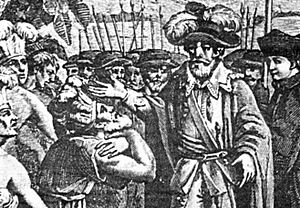
Salvador is located on a small piece of land that separates the Bay of All Saints from the Atlantic Ocean. This bay was first seen by a Portuguese explorer in 1501. In 1502, Amerigo Vespucci named it "Bay of the Saint Savior of All the Saints" because he saw it on All Saints' Day.
The first European to live nearby was Diogo Álvares Correia in 1509. He was shipwrecked and lived with the Tupinambá people. In 1549, Portuguese settlers led by Tomé de Sousa officially founded the city. They called it São Salvador da Bahia de Todos os Santos. It became Brazil's first capital and a very important port for the Atlantic slave trade and sugarcane industry.
The city was built with an "Upper City" for government and homes, and a "Lower City" for trade and the port.
Salvador's Role in Brazilian History
Salvador was the first place in Brazil to have a Roman Catholic diocese in 1551. Many religious groups, like the Jesuits, came to the city.
In 1624, the Dutch West India Company captured Salvador. However, a year later, a combined Portuguese and Spanish fleet took the city back. In 1763, the capital of Brazil was moved to Rio de Janeiro.
Salvador played a key role in Brazil's fight for independence from Portugal. The city was loyal to Portugal at first, but rebels fought for a year. On July 2, 1823, Portugal surrendered the city, and this day is now celebrated as Bahia Independence Day.
Modern Salvador Development
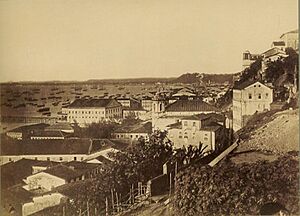
In 1873, Brazil's first elevator, the Lacerda Elevator, was built in Salvador. It connected the city's upper and lower parts and is still used today. By the time of the First World War, Salvador had railroads and streetcar lines.
In 1985, UNESCO declared the Pelourinho neighborhood a World Heritage Site. In the 1990s, a big project cleaned and restored this area to make it a cultural and tourist center.
Salvador has continued to grow and host major events. In 2010, it hosted a United Nations meeting on crime prevention. It also hosted games for the 2013 FIFA Confederations Cup and the 2014 FIFA World Cup.
Geography and Climate
Climate of Salvador
Salvador has a tropical rainforest climate. This means temperatures stay pretty much the same all year round. The driest months are December and January, while April, May, and June are the wettest.
| Climate data for Salvador (Bahia) 1991–2020 normals, extremes 1911–present | |||||||||||||
|---|---|---|---|---|---|---|---|---|---|---|---|---|---|
| Month | Jan | Feb | Mar | Apr | May | Jun | Jul | Aug | Sep | Oct | Nov | Dec | Year |
| Record high °C (°F) | 34.3 (93.7) |
34.7 (94.5) |
37.0 (98.6) |
34.5 (94.1) |
31.6 (88.9) |
30.6 (87.1) |
30.7 (87.3) |
31.3 (88.3) |
30.7 (87.3) |
33.5 (92.3) |
33.5 (92.3) |
34.3 (93.7) |
37 (99) |
| Mean daily maximum °C (°F) | 31.0 (87.8) |
31.1 (88.0) |
30.9 (87.6) |
29.6 (85.3) |
28.1 (82.6) |
27.1 (80.8) |
26.6 (79.9) |
26.7 (80.1) |
27.7 (81.9) |
29.1 (84.4) |
29.8 (85.6) |
30.6 (87.1) |
29.0 (84.2) |
| Daily mean °C (°F) | 26.9 (80.4) |
27.1 (80.8) |
27.1 (80.8) |
26.4 (79.5) |
25.3 (77.5) |
24.3 (75.7) |
23.7 (74.7) |
23.6 (74.5) |
24.3 (75.7) |
25.4 (77.7) |
26.1 (79.0) |
26.6 (79.9) |
25.6 (78.1) |
| Mean daily minimum °C (°F) | 23.8 (74.8) |
24.0 (75.2) |
24.1 (75.4) |
23.6 (74.5) |
22.8 (73.0) |
21.9 (71.4) |
21.1 (70.0) |
21.0 (69.8) |
21.5 (70.7) |
22.5 (72.5) |
23.1 (73.6) |
23.5 (74.3) |
22.7 (72.9) |
| Record low °C (°F) | 19.8 (67.6) |
19.5 (67.1) |
18.7 (65.7) |
18.7 (65.7) |
18.0 (64.4) |
18.2 (64.8) |
17.5 (63.5) |
17.7 (63.9) |
17.6 (63.7) |
18.3 (64.9) |
18.9 (66.0) |
19.8 (67.6) |
17.5 (63.5) |
| Average precipitation mm (inches) | 76.9 (3.03) |
98.7 (3.89) |
147.3 (5.80) |
284.9 (11.22) |
302.2 (11.90) |
237.6 (9.35) |
194.1 (7.64) |
129.7 (5.11) |
99.3 (3.91) |
91.0 (3.58) |
108.2 (4.26) |
63.4 (2.50) |
1,833.3 (72.18) |
| Average precipitation days (≥ 1.0 mm) | 9 | 9 | 11 | 16 | 18 | 19 | 18 | 16 | 11 | 8 | 8 | 7 | 150 |
| Average relative humidity (%) | 78.7 | 79.4 | 80.6 | 83.3 | 85.1 | 84.9 | 83.4 | 82.1 | 81.2 | 80.0 | 80.4 | 79.3 | 81.5 |
| Mean monthly sunshine hours | 234.8 | 208.2 | 225.5 | 185.4 | 156.7 | 144.6 | 169.6 | 190.4 | 205.3 | 226.6 | 202.9 | 222.8 | 2,372.8 |
| Source 1: Instituto Nacional de Meteorologia | |||||||||||||
| Source 2: Meteo Climat (record highs and lows) | |||||||||||||
People of Salvador
Salvador is the 5th largest city in Brazil by population. In 2020, it had over 2.4 million people.
Ethnic Groups in Salvador
| Race and ethnicity in Salvador | ||||
|---|---|---|---|---|
| Ethnicity | Percentage | |||
| Pardo (Multiracial) | 49.1% | |||
| Black | 34.1% | |||
| White | 16.5% | |||
| Amerindian | 0.2% | |||
| Asian | 0.1% | |||
Salvador's population is a mix of people from African, European, and Native American backgrounds. This mix has happened over 500 years. Many people have roots from countries like Benin, Nigeria, and Angola.
Studies show that the people of Salvador have a strong African heritage, along with European and Native American roots.
Population Growth Over Time
- Changing demographics of the city of Salvador

Source: Planet Barsa Ltda.
Religion in Salvador

Religion is a very important part of Salvador's culture, mixing Portuguese and African traditions. The city was the first place in colonial Brazil to have a Catholic bishop, in 1551. Many religious groups, like the Jesuits, came to the city to teach about Catholicism.
Over time, different religious orders and groups were formed, including ones for black men and women. These groups helped spread Catholicism and also provided social care, like hospitals for the poor.
Even with the growth of other religions, Catholicism is still a big part of Salvador. Some churches even hold Masses in the Yoruba language, with African songs and clothes, which attracts many people from Afro-Brazilian communities.
Many enslaved Africans brought to Bahia came from the Yoruba-speaking areas of present-day Benin. They were forced to become Catholic, but they secretly kept their original religion alive. They mixed their Yoruba beliefs with Catholic saints, creating a unique religion called Candomblé. For example, the Feast of Bonfim in January honors both Jesus Christ and the Candomblé deity Oxalá. Another important celebration is the Feast of Yemanja on February 2nd.
| Religion | Percentage | Number |
|---|---|---|
| Catholic | 51.55% | 1,379,252 |
| Protestant | 19.59% | 524,286 |
| No religion | 17.64% | 471,928 |
| Spiritist | 3.23% | 86,484 |
| Umbanda and Candomblé | 1.05% | 28,019 |
| Jewish | 0.04% | 1,010 |
Source: IBGE 2010.
Economy and Tourism
Salvador has always been important in Brazil's history because of its location on the coast. It had strong trade ties with Portugal and other Portuguese colonies.
Today, Salvador is the second most popular tourist spot in Brazil, after Rio de Janeiro. Tourism and cultural activities create many jobs and help the city's economy.
Popular Tourist Spots
Some of the most interesting places to visit are the famous Pelourinho district, its historic churches, and its beautiful beaches. Salvador has many places to stay, from hostels to fancy hotels.
The city's construction industry is also very active, with many companies investing in new buildings.
| Economy | GDP (in reais) | GDP per capita (in reais) |
|---|---|---|
| 2016 | 58 bilhões | 19.505,84 |
Beaches and Parks
Salvador has one of the longest coastlines in Brazil, with 80 km (50 miles) of beaches. Some beaches have calm waters, perfect for swimming and diving. Others have strong waves, great for surfers. There are also beaches with natural pools formed by reefs, which are safe for children.
Top Beaches and Islands to Explore
- Porto da Barra Beach was named the third best beach in the world by the Guardian newspaper in 2007.
- You can visit the large Itaparica island in the Bay of All Saints by ferry.
- The BA-099 Highway, also known as the "Line of Coconut" and "Green Line," has many beautiful beaches north of Salvador.
- Morro de São Paulo is an island across the Bay of All Saints, reachable by ferry or plane.
Green Spaces and Parks
Salvador has four main parks: Jardim dos Namorados Park, Costa Azul Park, Park of the City, and Pituaçu Park.
- Jardim dos Namorados is a large park with an amphitheater, sports courts, and playgrounds.
- Park of the City is an important area for preserving the Atlantic forest. It has beautiful flower gardens and special events for children.
- Pituaçu Park is one of the few ecological parks in a city in Brazil. It has a lake where you can ride pedal boats and a 38 km (24 miles) long bike path. There's also an outdoor museum called Espaço Cravo with sculptures and paintings.
- Colonial architecture in Salvador
Education in Salvador
Salvador has many important universities and colleges:
- Universidade Federal da Bahia (UFBA) (Federal University of Bahia)
- Universidade Católica do Salvador (UCSal) (Catholic University of Salvador)
- Universidade do Estado da Bahia (UNEB) (Bahia State University)
- Universidade Salvador (UNIFACS) (Salvador University)
- Instituto Federal da Bahia (IFBA) (Federal Institute of Bahia)
- Escola Bahiana de Medicina e Saúde Pública (EBMSP) (Bahian School of Medicine and Public Health)
Top High Schools in Salvador
- Pan American School of Bahia
- Colégio Marista
- Colégio São Paulo
- Colégio Oficina
- Colégio Anchieta
- Federal Institute of Bahia (IFBA)
- Colégio Bernoulli
- Cândido Portinari Academy
- Colégio Antônio Vieira
- Colégio Módulo
- Military College of Salvador
- Colégio Sartre Escola SEB
- Colégio Integral
- Colégio Gregor Mendel
Culture of Salvador
Salvador's culture is a rich mix of Native-Indian, African, and European traditions. This blend can be seen in the city's religion, food, music, and customs. African cultural practices are especially celebrated here.
Literature from Salvador
Many important writers are connected to Salvador. Gregório de Mattos, born in Salvador in 1636, was a famous poet. Father António Vieira, though born in Lisbon, grew up and was educated in Salvador and became known as one of the best writers of the Portuguese language.
Later, writers like Castro Alves and Ruy Barbosa became famous. In the 20th century, Jorge Amado helped share Salvador's culture with the world through his novels, many of which are set in the city.
Delicious Cuisine of Salvador

Salvador's food is spicy and often uses seafood. It has strong African influences, especially with ingredients like azeite-de-dendê, an oil from a palm tree brought from West Africa.
Many dishes use coconut milk, like Ensopados, Moquecas, and Escabeche. You can find traditional foods in Salvador's markets and restaurants. Popular dishes include caruru, vatapá, acarajé, bobó-de-camarão, moqueca baiana, and abará. Some of these foods are also used in Candomblé religious ceremonies.
Capoeira: Dance and Martial Art

Capoeira is a special mix of dance and martial art from Afro-Brazilian culture. It combines quick dance moves with unarmed fighting techniques. Salvador is considered the birthplace of modern capoeira styles. In the early 1900s, masters like Mestre Bimba and Mestre Pastinha from Salvador helped make capoeira popular around the world.
Museums in Salvador
Salvador's history and culture are kept alive in its many museums. The Museu de Arte da Bahia (MAB) is the oldest in the state. The Museu Náutico is located in the Forte de Santo Antonio da Barra, a historic fort. The Museum of Modern Art of Bahia is in a beautiful spot overlooking the Bay of All Saints.
Some churches and monasteries also have museums. Other important museums include the Museu do Cacau, State Museum of Geology, and Museu Rodin Bahia.
Carnival: The Biggest Party

The Bahian Carnival is known as the biggest party on Earth! For a whole week, almost 4 million people celebrate in the streets of Salvador. It's a huge event with lots of music, dancing, and colorful parades.
The music played is often axé or samba-reggae. Groups called blocos participate, with famous ones like Malé Debalé, Olodum, and Filhos de Gandhi.
The parades happen on different routes, or "circuits." The Osmar Circuit is the oldest. The Dodô Circuit runs along the coast, from Farol da Barra to Ondina.
Music of Salvador
Salvador is home to famous music groups like Olodum, Timbalada, and Ilê Aiyê. Many well-known singers and bands, such as Gilberto Gil and Daniela Mercury, are from Salvador. The city is also known for making unique musical instruments.
Handcrafts of Salvador
The handcrafts in Bahia use natural materials like straw, leather, clay, wood, and seashells. Artists often use religious themes, showing Catholic saints and Candomblé deities. Good luck charms like the clenched fist and Bonfim ribbons are also popular.
The main place to find handcrafts in Salvador is the Mercado Modelo, which is the biggest handcraft center in Latin America.
Transportation in Salvador
Airport for Travelers
The Deputado Luís Eduardo Magalhães International Airport is located 28 km (17 miles) north of central Salvador. The road to the airport is known for its beautiful scenery.
Port for Ships
The Port of Salvador, located in the Bay of All Saints, is a busy port. It handles the most containers in Brazil's North/Northeast regions and is a major exporter of fruit.
Metro System
The Salvador Metro system started running in 2014. It has two lines and 20 stations, connecting different parts of the city and linking to the bus system. The metro helps people get around Salvador, especially for big events like the 2014 FIFA World Cup.
Highways and Buses
Major federal highways connect Salvador to the rest of Brazil. The city also has a large number of public buses, transporting about 2 million people every day.
The main bus station (rodoviária) is in Iguatemi. From there, you can take buses to most major Brazilian cities and other places in Bahia.
Neighborhoods of Salvador
Salvador is divided into many different neighborhoods. For city management, it's split into 17 zones. However, the neighborhoods themselves are very important for their culture and history.
Some well-known areas include:
- West Zone: Pelourinho, Comércio, and Old Downtown.
- South Zone: Barra (with its beaches and Carnival circuit starting point), Vitória (with many tall buildings), Campo Grande (with its independence monument), Graça (a residential area), and Ondina (home to the Zoobotanical Garden).
- East Zone: Itaigara, Pituba, Horto Florestal, and Stella Maris are some of the wealthier communities.
- Lower City (Cidade Baixa): This area along the Bay of All Saints includes neighborhoods like Periperi and Liberdade. The Liberdade neighborhood has one of the largest populations of Afro-Brazilians in Salvador and Brazil.
Pelourinho: A Historic Treasure
The Historic Center of Salvador, especially the Pelourinho area, was named a World Heritage Site by UNESCO in 1985. It's a great example of Portuguese city planning from the 1500s, with its upper administrative town and lower commercial town. Many streets and colorful houses still look like they did long ago.
The word "Pelourinho" comes from the "pillories" that used to stand in public squares. These were symbols of authority but also of hardship for many. A big restoration project in the 1990s helped rebuild many buildings in Pelourinho, making it a popular tourist spot.
Salvador's wealth during colonial times can be seen in its grand old palaces, churches, and convents, mostly from the 17th and 18th centuries. Some famous ones include:
- Cathedral of Salvador: A beautiful church built in the 1600s.
- Convent and Church of São Francisco: Known for its amazing Baroque decorations.
- Church of Nosso Senhor do Bonfim: The most loved church in the city. Its festival in January is very important.
- Mercado Modelo (Model Market): A historic building that was once a customs house, now a market.
- Lacerda Elevator: An elevator built in 1873 that connects the upper and lower parts of the city. It carries 128 people in just 22 seconds!
Sports in Salvador
Salvador offers many sports activities for everyone.
Football (Soccer)
The city has a new football stadium called Itaipava Arena Fonte Nova, which can hold 56,000 people. This stadium hosted games for the 2013 FIFA Confederations Cup, the 2014 FIFA World Cup, and the 2016 Summer Olympics.
Salvador's main football teams are Esporte Clube Bahia and Esporte Clube Vitória. Bahia has won two national titles.
Other Popular Sports
- Volleyball: This sport has grown a lot in Salvador. There are state championships and beach volleyball events.
- Basketball: Basketball is very popular, especially among students. There are many courts and gyms around the city.
- Sailing: The Bay of All Saints is perfect for sailing. Salvador has good facilities for sailing and hosts many sailing events.
- Rowing: Rowing races started in Salvador over a hundred years ago. The city has new lanes for rowing at the Dique do Tororó area.
Notable People from Salvador
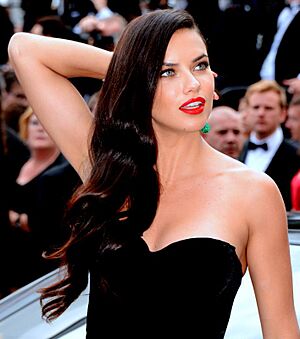
- Acelino Freitas: A boxer who was a 4-time World Champion.
- Robson Conceição: Won an Olympic gold medal in boxing in 2016.
- Hebert Conceição: Won an Olympic gold medal in boxing in 2021.
- Beatriz Ferreira: A boxer who is a World Champion and Olympic runner-up.
- Tony Kanaan: A famous race car driver.
- Ana Marcela Cunha: A swimmer specializing in open water marathons.
- Ricardo Santos: An Olympic champion in beach volleyball.
- Bebeto: A football (soccer) forward who won the World Cup in 1994.
- Dante: A professional soccer player.
- Carlinhos Brown: A well-known musician.
- Daniela Mercury: A famous musician.
- Wagner Moura: A talented actor.
- Adriana Lima: A world-famous supermodel.
- Manuel dos Reis Machado (Bimba): A legendary capoeira master.
- Raul Seixas: A popular musician.
International Connections
Salvador has "twin city" relationships with other cities around the world:
| Country | City | State / Region | Since |
|---|---|---|---|
| 1962 | |||
| 1985 | |||
| 1985 | |||
| 1985 | |||
| 1987 | |||
| 1992 | |||
| 1993 | |||
| Sciacca | 2001 | ||
| Harbin | 2003 | ||
| 2006 | |||
| 2011 |
See also
 In Spanish: Salvador (Bahía) para niños
In Spanish: Salvador (Bahía) para niños












